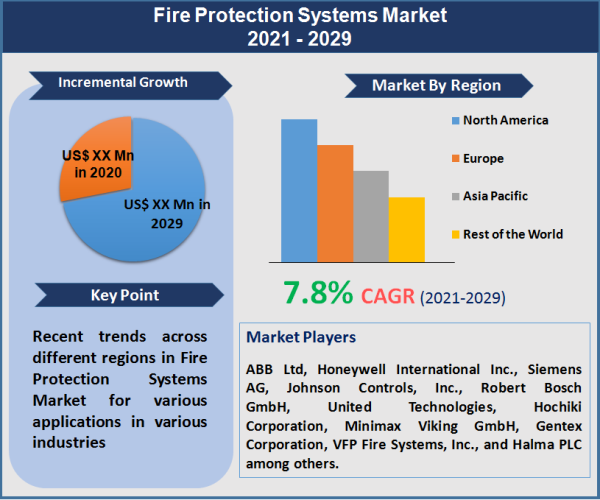
The global fire protection systems market expected to expand at a CAGR of 7.8% during the forecast period from 2021 to 2029. Increasing incidences of catastrophic fire accidents leading to number of casualties and loss of property across both industrial and non-industrial spaces is identified as the major factor driving demand for fire protection systems such as fire standpipes, fire suppressors, and fire alarm units among others. Accidental fire outbreaks and resulting property loss and casualties has convinced companies across the globe to install automated solutions for end-to-end fire detection and control. In addition, advancements in technology coupled with stringent regulations supporting safety at industrial as well as non-industrial spaces bodes well for the market growth worldwide. On the contrary, challenges associated with design, standards, development cycle, and maintenance of these systems are limiting its adoption worldwide.

Regulated Demand from Mining, Energy, and Oil & Gas Industries to Drive Growth Prospects
Industries prone to fire outbreaks such as oil & gas, energy & power, mining, and industrial manufacturing are some major end-users of fire protection systems. Considering high risk of fire outbreaks in these industry verticals, companies are compelled to install multiple automated safety solutions at their facility. Underlying threat to safety has triggered the need to install robust fire protection systems across upstream, midstream, and downstream operational fields in the oil & gas industry. With several forthcoming oil & gas projects, demand for new installations across these verticals will remain steady in the coming years. For instance, it is expected that over 125 crude and natural gas projects will start operations in Asia over the course of next seven years, driving market demand. Growth across these industries will also be driven by the replacement of conventional fire protection systems by state-of-the-art variants. For instance, the budding trend of replacing water sprinkler systems with mist-based fire suppression systems will drive market prospects during the forecast period from 2021 to 2029.
North America to Dominate, Europe to Register Steady Growth
In terms of value contribution, North America represented the largest fire protection systems market worldwide closely followed by Europe in 2020. Their collective contribution to the global fire protection systems was around two-third of the total market value in the same year. The U.S. was the largest fire protection systems market in North America and worldwide. Increasing shale gas exploration, upcoming deep-water drilling projects, and prevailing trend of refurbishing older high-rise buildings are identified as major factors driving demand for fire protection systems in the U.S. The fire protection systems market in North America is also expected to benefit from stringent regulations that promote workplace safety, driving installations of safety systems across industrial facilities. The fire protection systems market in Europe will continue to register steady growth on the back of replacement of conventional systems with state-of-the-art equivalents.
Key Players:
Some of the leading manufacturers profiled in the study include ABB Ltd, Honeywell International Inc., Siemens AG, Johnson Controls, Inc., Robert Bosch GmbH, United Technologies, Hochiki Corporation, Minimax Viking GmbH, Gentex Corporation, VFP Fire Systems, Inc., and Halma PLC among others.
Report Scope by Segments
Key segments covered in the report are as follows:
End-use Vertical Segment (2019–2029; US$ Bn)
Product Segment (2019–2029; US$ Bn)
Technology Segment (2019–2029; US$ Bn)
Historical & Forecast Period
This study report represents analysis of each segment from 2022 to 2032 considering 2023 as the base year. Compounded Annual Growth Rate (CAGR) for each of the respective segments estimated for the forecast period of 2024 to 2032.
The current report comprises of quantitative market estimations for each micro market for every geographical region and qualitative market analysis such as micro and macro environment analysis, market trends, competitive intelligence, segment analysis, porters five force model, top winning strategies, top investment markets, emerging trends and technological analysis, case studies, strategic conclusions and recommendations and other key market insights.
Research Methodology
The complete research study was conducted in three phases, namely: secondary research, primary research, and expert panel review. key data point that enables the estimation of Fire Protection Systems market are as follows:
Market forecast was performed through proprietary software that analyzes various qualitative and quantitative factors. Growth rate and CAGR were estimated through intensive secondary and primary research. Data triangulation across various data points provides accuracy across various analyzed market segments in the report. Application of both top down and bottom-up approach for validation of market estimation assures logical, methodical and mathematical consistency of the quantitative data.
| ATTRIBUTE | DETAILS |
|---|---|
| Research Period | 2022-2032 |
| Base Year | 2023 |
| Forecast Period | 2024-2032 |
| Historical Year | 2022 |
| Unit | USD Million |
| Segmentation | |
Technology
| |
End-use Vertical
| |
Product Type
| |
|
Region Segment (2022-2032; US$ Million)
|
Key questions answered in this report